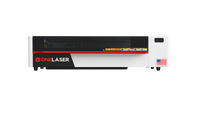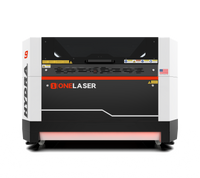Medium Density Fiberboard (MDF) is a great material for creative and industrial work. It's commonly used because it's flexible and even. MDF is perfect for laser cutting and engraving due to its engineered nature.
This article talks about the MDF laser engraving and cutting. You will learn about its characteristics, benefits, safety measures, and uses.

1. What is MDF?
MDF is made by mixing wood fibers with resin under high pressure and temperature. This creates a smooth, dense panel without grain patterns.
The consistent density of MDF ensures predictable results when using lasers. It helps achieve smooth cuts and engravings. However, the type and amount of resin can impact the outcome. It might affect edge charring and produce fumes.

A big advantage of MDF is its stability. Its uniform structure prevents warping when cut, aiding precise laser work. Its smooth surface suits detailed engravings, minimizing extra finishing work.
There are a few downsides, however. The resins in MDF may release harmful fumes when cut with lasers. Always ensure good ventilation and follow safety precautions. MDF also isn't as moisture-resistant as natural wood, so it's less ideal in humid areas.
When choosing MDF for laser cutting, go for premium or double-refined types. They perform better than regular MDF from general hardware stores.
2. MDF vs. Solid Wood
When engraving wooden projects, choosing between MDF and solid wood for laser engraving requires understanding their differences. MDF is an engineered material with a smooth, uniform surface, while solid wood has natural grain variations. Before starting your engraving, you should consider the following different factors of each.
Some of the key differences between the two can be found in this table:
|
Category |
MDF |
Solid Wood |
|
Material Composition |
Engineered wood composed of wood fibers and resin, offering a consistent, uniform structure. |
Natural wood harvested from trees, with variable grain patterns and inherent natural textures. |
|
Density & Uniformity |
Highly uniform density, ideal for predictable engraving and cutting performance. |
Variable density; natural grain may affect consistency in engraving detail and cutting quality. |
|
Surface Finish |
Smooth, even surface that is easy to sand and prepare for engraving. |
Distinctive grain patterns that add character but may require extra preparation for uniform results. |
|
Engraving Detail |
Capable of capturing high detail with minimal variations, though prone to charring if not optimized. |
Engraving quality can vary with wood species; some offer rich detail, while others may require careful adjustment. |
|
Cutting Quality |
Produces clean, uniform cuts when properly set up, ideal for mass production and prototypes. |
May yield rougher edges due to natural grain; requires precise settings and post-processing. |
|
Cost |
Generally more cost-effective and widely available, making it popular for budget projects. |
Typically higher in cost, favored for high-end, artisanal, or unique applications. |
|
Durability |
Stable for short to medium-term use; however, may not offer the longevity of natural wood. |
Often more durable and long-lasting with proper care, enhancing the value of premium products. |
|
Post-Processing |
Easier to sand and finish uniformly, yielding a consistent appearance. |
May require additional finishing to balance natural variations in grain and texture. |
|
Applications |
Ideal for prototypes, decorative items, and cost-effective mass production. |
Best suited for high-end custom projects, fine art, and pieces where natural aesthetics are paramount. |

3. Advantages of Laser Cutting MDF
Unlike natural wood, MDF lacks grain inconsistencies, which makes laser cutting MDF offers precision and efficiency, making it ideal for intricate designs and large-scale production. Its uniform composition ensures smooth, clean cuts with minimal imperfections.
3.1 Consistent, Clean Cuts
MDF's uniform composition facilitates precise and smooth cuts, accommodating intricate designs without the unpredictability associated with natural wood grains.
3.2 High Production Efficiency
The material's consistency allows for rapid processing, reducing machine downtime and material waste, thereby enhancing production efficiency.
3.3 Cost-Effectiveness
MDF's affordability, coupled with its availability in various thicknesses, offers a cost-effective solution for projects requiring large volumes of material.
3.4 Versatility in Design
The absence of natural defects enables designers to execute complex and detailed patterns, expanding creative possibilities.
3.5 Minimal Post-Processing Requirements
Laser-cut MDF typically exhibits clean edges, reducing the necessity for extensive sanding or finishing, thus streamlining the production process.

4. Advantages of Laser Engraving MDF
MDF's smooth, uniform surface makes it highly receptive to laser engraving, allowing for crisp, detailed designs with minimal variation. Unlike solid wood, which has unpredictable grain patterns, MDF provides a consistent engraving depth and texture. This makes it ideal for intricate engraving.
4.1 Uniform Engraving Depth
The material's homogeneity ensures consistent engraving depths, resulting in high-quality and precise designs.
4.2 Enhanced Detail Resolution
MDF's smooth surface allows for the reproduction of fine details, making it suitable for intricate artwork and detailed text.
4.3 Reduced Material Waste
Efficient material utilization during engraving minimizes waste, contributing to cost savings and environmental sustainability.
4.4 Adaptability to Complex Patterns
MDF can accommodate elaborate and multi-layered engravings, offering versatility for various design requirements.
4.5 Ease of Finishing
Post-engraving, MDF can be effortlessly sanded, painted, or sealed, facilitating a polished and professional final product.

5. Is it Safe to Cut and Engrave MDF?
While MDF is widely used in laser cutting and engraving, it is essential to consider safety precautions due to the materials used in its production.
MDF contains urea-formaldehyde resins, which can release formaldehyde gas when heated. Inhaling these fumes may pose health risks.
Therefore, it is crucial to operate laser equipment in well-ventilated areas and utilize appropriate fume extraction systems to mitigate exposure.
6. How to Avoid Over Burning When Laser Cutting and Engraving
To avoid over burning and fire hazard when laser cutting and engraving MDF, the below methods can help:
6.1 Set the Right Parameters
Adjusting laser settings such as power, speed, and frequency is vital to prevent over burning. Conducting test runs on scrap pieces of MDF can help determine optimal parameters for the desired outcome.
Learn more: MDF Laser Parameters Settings
6.2 Use a Honeycomb Table
Employing a honeycomb cutting table can reduce the risk of over burning by minimizing the contact area between the material and the work surface. This setup allows for better heat dissipation and reduces the likelihood of scorch marks on the underside of the material.
6.3 Use an Air Assist System
An air assist system directs a stream of air onto the cutting or engraving area, helping to dissipate heat and remove debris. This feature not only prevents over burning but also enhances the quality of the cut or engraving by keeping the laser path clear.
6.4 Improve Exhaust System
A robust exhaust system is essential for removing fumes and particulate matter generated during laser processing. Effective fume extraction not only protects the operator's health but also prevents residue buildup on the material surface, which can lead to over burning.
6.5 Choosing The Right Laser Engraving Machine
Choosing the right laser engraver is essential for achieving high-quality results when working with MDF. OneLaser's Hydra Series and X Series are excellent choices, offering precision, power, and reliability for both engraving and cutting.
The OneLaser Hydra is perfect for detailed engraving and cutting projects, thanks to its adjustable settings and precise control. Its versatility allows for clean, sharp details, making it an ideal option for intricate MDF designs.

For those requiring more power and efficiency, the OneLaser X Series excels at both engraving and cutting. With its robust laser output and larger working area, it ensures smooth edges and deep cuts, making it suitable for large-scale MDF projects.

7. How to Laser Engrave and Cut MDF
Process of laser engraving and cutting MDF is various in many ways. However, the principles are similar. Here we have a general guide to laser engrave and cut on MDF.
7.1 What to Prepare?
- OneLaser 38W XRF Laser Engraver
- A piece of 40*25cm 3mm thick MDF Board
- Color Pens and White Emulsion
7.2 General Guide to Laser Engrave and Cut MDF
Step #1
Prepare the piece of MDF board. Before cutting and engraving, cleaning up or polishing the surface will help produce a clearer pattern and cutting edge.

Step #2
Turn on the OneLaser XRF engraving machine. Connect the machine to your computer via the data cable. Enable your cooling and exhausting systems, they will help reduce the over burning and prevent a fire hazard.
Step #3
Turn on your computer and open your choice of laser engraving software. Here we use LightBurn. Set the parameters after testing, and upload the file to the machine. It's recommend to start the parameters around:
Cutting 3mm MDF: 80% power, 10mm/s

Engraving MDF: 50% power, 500mm/s

Step #4
Press the Auto-focus button and the laser machine will adjust the head height according to the thickness of the MDF board.
Step #5
Start cutting and engraving with just one click and the XRF will engrave an intricate pattern and cut a clear edge in the MDF!

Step #6
Finally, after you have cut all the components you need, color the letters with color pens, and stick them with glue.

Wait a few minutes to let it dry and you will have a lovely MDF tissue box!
Conclusion
Laser cutting and engraving MDF offer numerous advantages, including precision, efficiency, and versatility. By understanding the material's properties and implementing appropriate techniques and safety measures, professionals and hobbyists alike can achieve high-quality results in their projects.






